Section 5.3. Organization Schemes
5.3. Organization SchemesWe navigate through organization schemes every day. Telephone books, supermarkets, and television programming guides all use organization schemes to facilitate access. Some schemes are easy to use. We rarely have difficulty finding a friend's phone number in the alphabetical organization scheme of the white pages. Some schemes are intensely frustrating. Trying to find marshmallows or popcorn in a large and unfamiliar supermarket can drive us crazy. Are marshmallows in the snack aisle, the baking ingredients section, both, or neither? In fact, the organization schemes of the phone book and the supermarket are fundamentally different. The alphabetical organization scheme of the phone book's white pages is exact. The hybrid topical/task-oriented organization scheme of the supermarket is ambiguous. 5.3.1. Exact Organization SchemesLet's start with the easy ones. Exact or "objective" organization schemes divide information into well-defined and mutually exclusive sections. The alphabetical organization of the phone book's white pages is a perfect example. If you know the last name of the person you are looking for, navigating the scheme is easy. "Porter" is in the Ps, which are after the Os but before the Qs. This is called known-item searching. You know what you're looking for, and it's obvious where to find it. No ambiguity is involved. The problem with exact organization schemes is that they require users to know the specific name of the resource they are looking for. The white pages don't work very well if you're looking for a plumber. Exact organization schemes are relatively easy to design and maintain because there is little intellectual work involved in assigning items to categories. They are also easy to use. The following sections explore three frequently used exact organization schemes. 5.3.1.1. AlphabeticalAn alphabetical organization scheme is the primary organization scheme for encyclopedias and dictionaries. Almost all nonfiction books, including this one, provide an alphabetical index. Phone books, department-store directories, bookstores, and libraries all make use of our 26-letter alphabet for organizing their contents. Alphabetical organization often serves as an umbrella for other organization schemes. We see information organized alphabetically by last name, by product or service, by department, and by format. Figure 5-2 provides an example of a departmental directory organized alphabetically by last name. Figure 5-2. A directory of people at Microsoft Research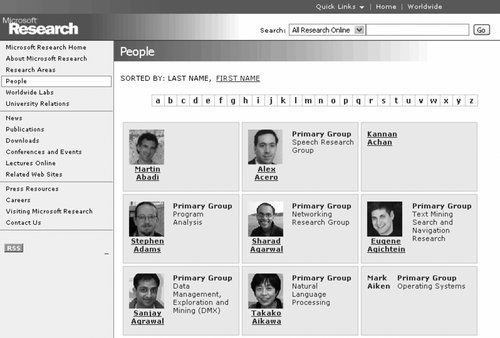 5.3.1.2. ChronologicalCertain types of information lend themselves to chronological organization. For example, an archive of press releases might be organized by the date of release. Press release archives are obvious candidates for chronological organization schemes (see Figure 5-3). The date of announcement provides important context for the release. However, keep in mind that users may also want to browse the releases by title, product category, or geography, or to search by keyword. A complementary combination of organization schemes is often necessary. History books, magazine archives, diaries, and television guides tend to be organized chronologically. As long as there is agreement on when a particular event occurred, chronological schemes are easy to design and use. Figure 5-3. Press releases in reverse chronological order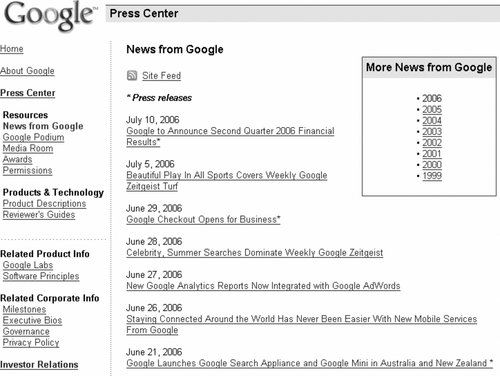 5.3.1.3. GeographicalPlace is often an important characteristic of information. We travel from one place to another. We care about the news and weather that affects us in our location. Political, social, and economic issues are frequently location-dependent. And, in a world where mobile devices such as Blackberries and Treos are becoming location-aware, while companies like Google and Yahoo! are investing heavily in local search and directory services, the map as interface is enjoying a resurgence of interest. With the exception of border disputes, geographical organization schemes are fairly straightforward to design and use. Figure 5-4 shows an example of a geographical organization scheme. Users can select a location from the map using their mouse. Figure 5-4. A geographical organization scheme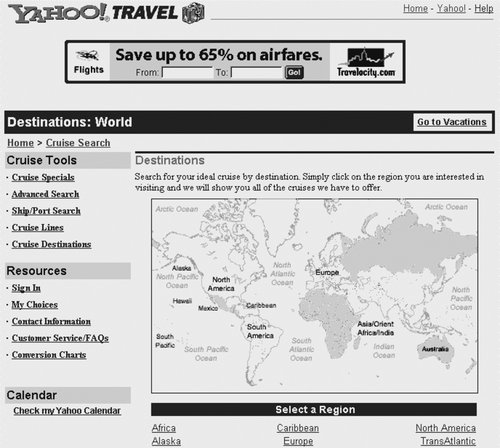 5.3.2. Ambiguous Organization SchemesNow for the tough ones. Ambiguous or "subjective" organization schemes divide information into categories that defy exact definition. They are mired in the ambiguity of language and organization, not to mention human subjectivity. They are difficult to design and maintain. They can be difficult to use. Remember the tomato? Do we classify it under fruit, berry, or vegetable? However, they are often more important and useful than exact organization schemes. Consider the typical library catalog. There are three primary organization schemes: you can search for books by author, by title, or by subject. The author and title organization schemes are exact and thereby easier to create, maintain, and use. However, extensive research shows that library patrons use ambiguous subject-based schemes such as the Dewey Decimal and Library of Congress classification systems much more frequently. There's a simple reason why people find ambiguous organization schemes so useful: we don't always know what we're looking for. In some cases, you simply don't know the correct label. In others, you may have only a vague information need that you can't quite articulate. For these reasons, information seeking is often iterative and interactive. What you find at the beginning of your search may influence what you look for and find later in your search. This information-seeking process can involve a wonderful element of associative learning. Seek and ye shall find, but if the system is well designed, you also might learn along the way. This is web surfing at its best. Ambiguous organization supports this serendipitous mode of information seeking by grouping items in intellectually meaningful ways. In an alphabetical scheme, closely grouped items may have nothing in common beyond the fact that their names begin with the same letter. In an ambiguous organization scheme, someone other than the user has made an intellectual decision to group items together. This grouping of related items supports an associative learning process that may enable the user to make new connections and reach better conclusions. While ambiguous organization schemes require more work and introduce a messy element of subjectivity, they often prove more valuable to the user than exact schemes. The success of ambiguous organization schemes depends upon the quality of the scheme and the careful placement of individual items within that scheme. Rigorous user testing is essential. In most situations, there is an ongoing need for classifying new items and for modifying the organization scheme to reflect changes in the industry. Maintaining these schemes may require dedicated staff with subject matter expertise. Let's review a few of the most common and valuable ambiguous organization schemes. 5.3.2.1. TopicOrganizing information by subject or topic is one of the most useful and challenging approaches. Phone book yellow pages are organized topically, so that's the place to look when you need a plumber. Academic courses and departments, newspapers, and the chapters of most nonfiction books are all organized along topical lines. While few web sites are organized solely by topic, most should provide some sort of topical access to content. In designing a topical organization scheme, it is important to define the breadth of coverage. Some schemes, such as those found in an encyclopedia, cover the entire breadth of human knowledge. Research-oriented web sites such as Consumer Reports (shown in Figure 5-5) rely heavily on their topical organization scheme. Others, such as corporate web sites, are limited in breadth, covering only those topics directly related to that company's products and services. In designing a topical organization scheme, keep in mind that you are defining the universe of content (both present and future) that users will expect to find within that area of the web site. Figure 5-5. This topical taxonomy shows categories and subcategories 5.3.2.2. TaskTask-oriented schemes organize content and applications into a collection of processes, functions, or tasks. These schemes are appropriate when it's possible to anticipate a limited number of high-priority tasks that users will want to perform. Desktop software applications such as word processors and spreadsheets provide familiar examples. Collections of individual actions are organized under task-oriented menus such as Edit, Insert, and Format. On the Web, task-oriented organization schemes are most common in the context of e-commerce web sites where customer interaction takes center stage. Intranets and extranets also lend themselves well to a task orientation, since they tend to integrate powerful applications or "e-services" as well as content. You will rarely find a web site organized solely by task. Instead, task-oriented schemes are usually embedded within specific subsites or integrated into hybrid task/topic navigation systems, as we see in Figure 5-6. Figure 5-6. Task and topic coexist on the eBay home page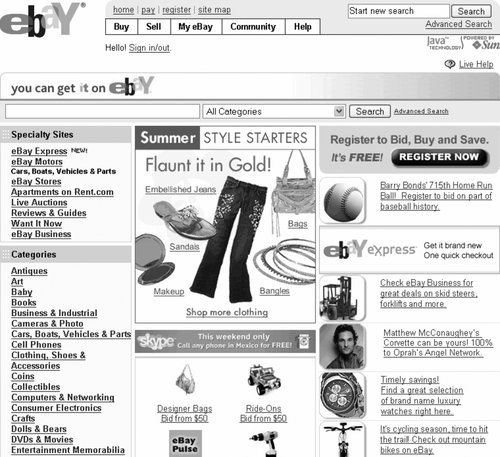 5.3.2.3. AudienceIn cases where there are two or more clearly definable audiences for a web site or intranet, an audience-specific organization scheme may make sense. This type of scheme works best when the site is frequented by repeat visitors who can bookmark their particular section of the site. It also works well if there is value in customizing the content for each audience. Audience-oriented schemes break a site into smaller, audience-specific mini-sites, thereby allowing for clutter-free pages that present only the options of interest to that particular audience. The main page of dell.com, shown in Figure 5-7, presents an audience-oriented organization scheme (on the right) that invites customers to self-identify. Figure 5-7. Dell invites users to self-identify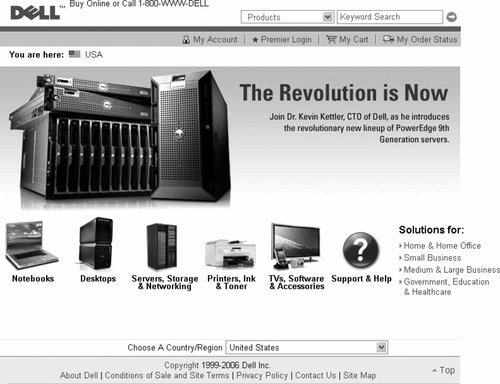 Organizing by audience brings all the promise and peril associated with any form of personalization. For example, Dell understands a great deal about its audience segments and brings this knowledge to bear on its web site. If I visit the site and identify myself as a member of the "Home & Home Office" audience, Dell will present me with a set of options and sample system configurations designed to meet my needs. In this instance, Dell might make the educated guess that I probably need a modem to connect to the Internet from my home. However, this guess would be wrong, since I now have affordable broadband access in my community. I need an Ethernet card instead. All ambiguous schemes require the information architect to make these educated guesses and revisit them over time. Audience-specific schemes can be open or closed. An open scheme will allow members of one audience to access the content intended for other audiences. A closed scheme will prevent members from moving between audience-specific sections. This may be appropriate if subscription fees or security issues are involved. 5.3.2.4. MetaphorMetaphors are commonly used to help users understand the new by relating it to the familiar. You need not look further than your desktop computer with its folders, files, and trash can or recycle bin for an example. Applied to an interface in this way, metaphors can help users understand content and function intuitively. In addition, the process of exploring possible metaphor-driven organization schemes can generate new and exciting ideas about the design, organization, and function of the web site. While metaphor exploration can be useful while brainstorming, you should use caution when considering a metaphor-driven global organization scheme. First, metaphors, if they are to succeed, must be familiar to users. Organizing the web site of a computer-hardware vendor according to the internal architecture of a computer will not help users who don't understand the layout of a motherboard. Second, metaphors can introduce unwanted baggage or be limiting. For example, users might expect a digital library to be staffed by a librarian that will answer reference questions. Most digital libraries do not provide this service. Additionally, you may wish to provide services in your digital library that have no clear corollary in the real world. Creating your own customized version of the library is one such example. This will force you to break out of the metaphor, introducing inconsistency into your organization scheme. In the Teletubbies example in Figure 5-8, the games area is organized according to the metaphor of a physical place, populated by creatures and objects. This colorful approach invites exploration, and children quickly learn that they must go "inside Home Hill" to play with the machine called "Nu Nu." Since most of the target audience can't read, an overarching visual metaphor is a great solution. But unless your web site is aimed at young children, metaphor should probably play only a niche role. Figure 5-8. The Teletubbies' metaphor-driven games area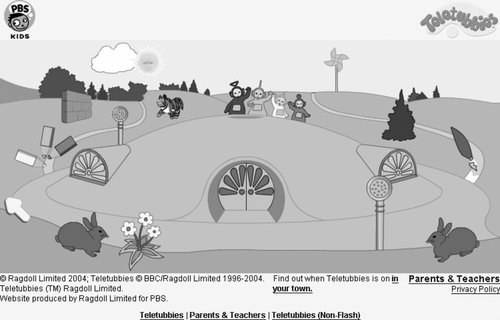 5.3.2.5. HybridsThe power of a pure organization scheme derives from its ability to suggest a simple mental model that users can quickly understand. Users easily recognize an audience-specific or topical organization. And fairly small, pure organization schemes can be applied to large amounts of content without sacrificing their integrity or diminishing their usability. However, when you start blending elements of multiple schemes, confusion often follows, and solutions are rarely scalable. Consider the example in Figure 5-9. This hybrid scheme includes elements of audience-specific, topical, metaphor-based, task-oriented, and alphabetical organization schemes. Because they are all mixed together, we can't form a mental model. Instead, we need to skim through each menu item to find the option we're looking for. Figure 5-9. A hybrid organization scheme The exception to these cautions against hybrid schemes exists within the surface layer of navigation. As illustrated by eBay (see Figure 5-6), many web sites successfully combine topics and tasks on their main page and within their global navigation. This reflects the reality that both the organization and its users typically identify finding content and completing key tasks at the top of their priority lists. Because this includes only the highest-priority tasks, the solution does not need to be scalable. It's only when such schemes are used to organize a large volume of content and tasks that the problems arise. In other words, shallow hybrid schemes are fine, but deep hybrid schemes are not. Unfortunately, deep hybrid schemes are still fairly common. This is because it is often difficult to agree upon any one scheme, so people throw the elements of multiple schemes together in a confusing mix. There is a better alternative. In cases where multiple schemes must be presented on one page, you should communicate to designers the importance of preserving the integrity of each scheme. As long as the schemes are presented separately on the page, they will retain the powerful ability to suggest a mental model for users. For example, a look at the Stanford University home page in Figure 5-10 reveals a topical scheme, an audience-oriented scheme, an alphabetical index, and a search function. By presenting them separately, Stanford provides flexibility without causing confusion. Figure 5-10. Stanford provides multiple organization schemes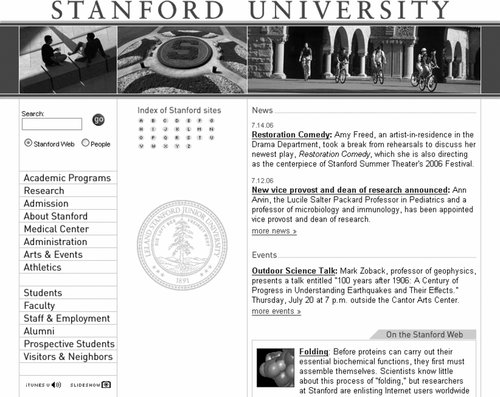 |
EAN: 2147483647
Pages: 194